
(Note to those people who might think a parody of a quack remedy guide that pretends to be from the 19th Century could really contain factual information but who are too stupid to read disclaimers such as this anyway: The information contained herein is absolutely and utter balderdash, provided by Sierra On-Line, Inc. for your Entertainment ONLY and to provide information and clues for FREDDY PHARKAS, FRONTIER PHARMACIST. Do not take the medications we prescribe. Do not apply the balms and liniments we describe. Do not attempt the procedures we outline. Do not believe that Manual Labor is still the President of Mexico. Nothing within this pamphlet is accurate and truthful, to the best of our ability. We are being facetious. Do not, repeat DO NOT, use this documentation as a real medical guide! It's a joke! Okay? Get it?)
As the dawn of a new era in health care peers uncertainly over the horizon like an innocent young man peers over the top of my desk during his first visit to my world-famous Phrenology Clinic and Hair Club for Boys, I cannot help but reflect on the enormous strides we've made just in the past several decades as regards certain heretofore debilitating conditions, which have been all but eradicated thanks to the hard work and diligence of phrenologists like me and sometimes, peripherally, by other health care professionals worldwide.
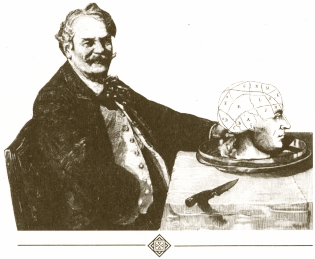
At the Phrenologists for Health, Enervating Elixirs, Longevity, and Mental Energy Institute, our goal is to ensure the dissemination to all Americans of the techniques and formulae developed in recent years that will guarantee fitness, prosperity and energy well into one's twilight years (40 and over). Latter-day research indicates that you may well be able to retard the aging process and extend your life will into the 50s and 60s, provided you adhere to a long-term commitment to proper diet (fat-rich foods for stamina and bulk, sweetened foodstuffs for energy and improved alertness, red meat for iron and other necessary minerals), ingesting the proper tonics (try my “Doctor's Best Guess,” a balanced elixir of herbal and fermented ingredients), careful head manipulation and bump-stimulation and a de-emphasis on physical exertion at all costs.
For instance, in my seperate monograph “Subdural Hematomas Can Be Your Friends” (available for only $2.00 cash, sent in care of my publisher; be sure to enclose an extra $0.25 if you'd like the autographed version, and for an extra $0.50, we'll ship via Fars Wellgo rather that the less dependable Postal Office Rural Free Delivery), I describe an exercise of systematic cranial stimulation of a portion of the left temporal lobe, wherin lies the fornicrux of the brain that controls longevity. By daily providing a quick, sharp repetitive stimulation of this lobe (achieved with any common household hammer or even a goodm solid book binding such as can be found on my new top-selling edition, “Cranial Protuberances And The Women Who Fell Them!”, $3.00 from the aforementioned publisher), one may cause greater amounts of longevity fluids to flow and, with the single technique, extend the life by any number of years. Any slight pain or discomfort that may be encountered by those sissy-marys who may complain is therapeutic, and any blood drawn as a result of the practice can be safely assumed to be a tainted bile and well rid-of. This assumes, of course, that the subject does not apply excess force and thus shorten the life span drastically and forthwith.
“How much force is enough?” you ask. Purchase the volume and read for yourself.
It is our sincere hope that you find within these pages a plethora of useful and hitherto unanticipated direction designed to improve the quality and length of life. We have endeavored to address the spectrum of ailments treatable by the public at large as well as by professionals such as phrenologists, druggists, and barbers. this cornucopia of misery includes accidental & purposeful poisonings, hair loss, melancholia, lassitude, flatulence, flassitude, latulence, bad bile, Lowe's Syndrome, piles, inhalation of noxious substances, tooth pain, lice, scabies, rabies, heartburn, Indian burn, and bullet or arrow wounds. Should we have omitted any of your favourite diseases or injuries, please jot me a note in care of my publisher (and don't fail to include an extra $1.50 for my latest monograph, “Cardiology: The New Quackery”).
Mankind has made phenomenal strides in the diagnosis and treatment of disease. No longer are we taking the naive viewpoint of our ancestors, pointing our fingers at the sick and scabrous and crying, “Gadzooks, he's infested by evil spirits and daemons!” No, we now know that thye root causes of disease are far less eatheral and far more commonplace: some are caused by the collection of toxins within the system, and some are caused by poorly-shaped or missing bumps on the skull. The former we shall address in this, “The Modern Day Book of Health and Hygiene”; the latter is well covered in my companion volume, “The Modern Day Book of Sharp Blows to the Head.”
To effectively use this book, you will want to stock your medicine chest with the various items listed in part 1, “The Household Pharmacopoeia.” Every item listed can be located for purchase at your local general merchandise store, at a large metropolitan pharmacy, or from me at my associated firm, Lipschitz Excelsior Total Chemicals and Household Supplies, Catalog available upon request; we feature top-quality merchandise at competiotive prices. Write me in care of my publisher and we'll have you stocked and fully prepared for all medical emergencies and home treatments in a thrice.
In the reference section, you'll find an alphabetical listing of many common ailments and disease, as well as a complete description of the most modern and up-to-date treatments medical science and phrenology have to offer. Some of the treatments are cross- referenced under their own headings, for ease of use.
Although we have taken great pains to make this the most complete and comprehensive home physician book available, there are no doubt questions you may have concerning treatments and recuperative processes. We will be utterly happy to answer any and all questions put to us, via post, at the nominal charge of $0.55 per question. Stamps are not accepted.
Herewith, then, to your good health, good fortune, and good healing!

The following is a list of desireable household equipment for proper treatment of common ailments, and for creating the balms, salves, liquids and tablets described forthwith. All items may be purachased through us or at finer pharmecological equipment stores nationwide.
Note: the usual household medicine cabinet is somewhat on the small side for the amount of equipment we suggest. Therefore, we also recommend a larger than average medicine cabinet to hold this equipment. Something about the size of a small banquet hall should be sufficient.
You will also require the following chemicals and perishables:
A powerful anti-swelling agent. Available from Nostril Nostrums, Ltd., Conception Junction, Missouri. See: NOSE DROPS.
An extremely powerful cure for temporary (Non-Acute) flatulence, in man or beast. Should Aminophyllic Citrate be unavailable, it may be created in the home laboratory: Combine 40 grams Sodium Bicarbonate with 15 ml. Furachlordone. Pour into beaker. Dilute with water to make 100 ml. Add 5 grams Magnesium Sulfate, stir the mixture well using only a pure glass rod. Pour into medicine bottle and cork. Mix 1:1000 with water.
A colorless, pungent gas, achieved through dry distillation of nitrogenous organic bodies such as blood and bones. Not recommended for synthesis at home. When infused with water, often called “Spirits of Hartshorn.”
Soluble ammonia is a decent disinfectant… and it DOESN'T leave streaks!
Pungent crystals, often called “smelling salts.” Available widely, or from D. P. Grumby Ammonium Carbonate Co., Theale-on-Line, Berkshire, England.
One of the greatest hoaxes ever perpetrated upon the unwitting public, and a darn fine one, too. Does not actually provide any medication as analgesics work on the brain and not on localized sites. However by creating a stinging or burning discomfort on the skin, it effectively distracts from the ache or pain for which the rub is used. See: RUBEFACENT. Often fools senior citizens and adults; unfortunately children cannot be decieved quite as easily. A jocular item to keep around the locker room.
Important to have at available at all times. Whisky and other high-proof alcoholic beverages will serve; ether, chloroform and a sharp blow to the head will also suffice (see my above-mentioned, “The Modern Day Book of Sharp Blows to the Head”). Biting down on bullets is only recommended provided the bullet is facing outward from the head and away from innocent bystandars.
There are numerous antacids available. Most appear to be combinations of Sodium Bicarbonate and Calcium Carbonate. See: SODIUM BICARBONATE, CALCIUM CARBONATE. Extract of Swiss Lemon Creme is useful to make these more palatable.
An anitpyretic, antirheumatic, analgesic pill consisting of the acetyl derivative of salicylic acid. So far, the basic usage seems to be for keeping cut flowers from wilting, but new experimental uses are being explored all the time.
An ointment or liniment, rubbed on external sites to provide temporary symtomatic relief of aches, pains, bruises and other localized pain. Oil of Belladonna and Nightshade Jelly are two particularly effective balms; however, it is inadvisable to take them internally.
A crystalline substance used in the manufacture of certain drugs. Hard-to-find but well worth a trip to the Joliet Bimenthylquinoline Mines to pick up some freshly-hewn granules.
Has been found to be an effective, albeit highly powerful, compound in the correction of diarrhea, although it is not normally recommended for individuals due to its extreme concentration and possibility for overdose, with subsequent dire consequences. Best when taken with vast quantities of water. Storage may be a problem due to short shelf life. May be synthesized as follows: Combine 25 ml. of Bismuth Subsalicylate with 5 ml. of Orphenamethihydride in a test tube. Heat over flame until mixture begins to boil. Pour into medicine bottle and cork. Remove from flame and dilute with one thousand gallons of water (approximately). Makes enough Bisalicylate Antitoxidene for four thousand doses.
Used in the compounding of drugs such as Beinbyate, Lezl-E Neelcin, Sudabum, and Quinotrazate.
Primarily prescribed as a stool darkener. Some believe it to be efficacious in a variety of digestive aids.
A catch-all name for any of a variety of chemicals which can leech color, but often referring specifically to Sodium Hypochlorite, an oxidizing compound. Sodium Hypochlorite can also be used as a decontaminating agent for various types of gasses. Apply to liver spots thrice daily; will not eradicate liver spots but will certainly irritate them into forming scabs, thus disguising them.
Also known as “20 Mule Team Borax.” A white crystalline compound used as an antiseptic, as a food preservative, for various medical purposes and as a flux. Found native as “tincal” and with a sweet, alkaline taste.
A white crystalline compound, used as a mild antiseptic and sometimes as a preservative. Found in volcanic lagoons of Tuscany, Italy. Really.
A reletively new ingredient in the home medicine arsenal. Currently used mainly as a flavoring agent in coffee, chocolate, and the new “carbonated” beverages, but believed by many modern-day physicians to soothe agitated nerves and calm excitable children. Experimentation is currently underway to confirm this.
A soothing pink lotion consisting of zinc and ferric oxide in a suspension. Useful for a variety of skin ailments. Comforting to victim, only because it brings to mind when grandma used to take you for long walks in the poison ivy and then had to slather you with the stuff afterwards. Remember?
Used to provide that much sought-after “chalky” texture for antacids, laxatives, diuretics, and other bowel-related liquid medications. Can be synthesized in the home thusly: Take one 5-inch length of schoolhouse chalk. Grind in a mortar until a fine powdery consistency is achieved. Use 1 gm powder per dosage as recommended.
Added to make certain children's medication more palatable. In pill-based medications, imparts a malleable texture allowing you to mold the pills into the dinosaur shapes children love to eat (except for Betty)!
Also known as granulated charcoal. Despite the mess and inconvenience, carbon makes a serviceable deodorant, and can even be used to filter some gaseous fumes, such as methane, from air to make it breathable. Cheap and readily available.
Primarily used to prove to children who's really the boss around this house, and your gonna take this and go straight to bed or wish you had of!
A delightful additive to heighten the enjoyment gained from certain highly-alcoholic remedies and elixirs. Also used as a sedative with humans and animals.
The narcotic of choice when compounding expectorants and couch suppressants. May create nausea upon consumption; fortunately, the narcotic effect ensures that the patient does not care about the nausea.
Bluestone. Used to achieve a pleasant color in many preparations. Can also be added to non-medicated drinks to produce bizarre and amusing efects. Breaks the ice at parties.
Edible tablets of soothing or medicinally-treated candy. Some of the best commercially available cough drops are: Mergatroyd Bros. Licorice 'n Dioctyl Sodium Sulfosuccinate Drops, Halley's Mentho-Propylene Glycol Troches, and Ludnick's Honey, Lemon and Sorbitan Monostearate Lozenges.
Some suppress coughs, some cause the patient to expectorate (cough up phlegm). Preparations that claim to do both are useless and cancel each other out. Can be synthesized at home as follows: to 20 ml. Mercuriomuculate Dioxide, add 15 gm. Essence of Butyrachrome. Heat slowly until dissolved. Cool. Stopper. Shake. Dosage: 1 tsp. per hour as needed.
A medication that stimulates the secretion and flow of urine. Beer appears to be extremely efficacious. The saying goes, “You can't buy a diuretic… you can only rent one!”
Often a gentle formulation of Hydrogen Peroxide, designed to slowly dissolve accumulations of ear wax that may be causing blockages or exacerbating infections. Use caution when applying; remember the rule of thumb: never place anything larger than your elbow into your ear.
A general term used in hundreds of liquid “patent medicines”. May contain herbal or synthetic chemicals, or a combination of those. Most elixirs have, in common, an extremely high alcohol content, often up to 95% of the contents of the bottle. Thus, they may be more effective in creating flambés than in battling illness.
Used in the formulation of Testostearate, Einbinder Digestive Salts, Myomiomy, and other remedies. Warning: should not be consumed by those with “I'm Allergic to Enteromagneline” medic alert badges, medic alert rings, medic alert necklaces, medic alert cloisonnés, or medic alert cameos.
See: MAGNESIUM SULFATE.
Can be used to prevent conception after marital relations. Normally available only by prescription. May be produced in the home as follows: Grind 15 gm. of Bimethylquinoline crystals and 15 gm. of powdered Metyraphosphate in a mortar. Prepare 5 gm. dosages on pure sheets of medicinal dispensing paper. Recommended maximum dosage: 1 box of six.
The woman who invented the hangover. Also a convenient fluid in which to dissolve many compounds, having a higher solvency factor than plain, boring old water.
Despite claims to the contrary, water is all that is needed in most cases where eye drops or eyewash is required. Eye drops may be useful to flush foreign objects from the surface of the eyeball, or to moisten dry eyes. To prevent dry eyes, try not to rub your eyes with a rough, absorbent towel.
See: EYE DROPS.
A toxic, unpleasantly-scented preserving gel. Should any organs or limbs need to be preserved for any reason, plunge immediately into a jar of formaldehyde once the vital fluids have been drained.
Used in the manufacture of Aminophyllic Citrate, Limnotic Knidphyte, Chloroslychmun, and other popular medications. Also useful as a topical remedy for poison ivy, poison oak, poison sumac, poison honeysuckle, and poison lily-of-the-valley.
Usually proffered in syrup form. Causes instant and severe vomiting, useful in the event of accidental poisoning. Also tremendous fun when secretly added to the chocolate syrup dispensers of competing pharmacies.
Used in perfumery and as a solvent; can also be used for rubdowns and as a topical refresher. Bracing. Do not drink.
A purgative; something that enables the body to better void or eliminate fecal matter. Psyllium husk is a good natural laxative; many fiber-rich foods also have a natural laxative effect. See: CALCIUM CARBONATE, MILK OF MAGNESIA, MINERAL OIL, PSYLLIUM.
They're not just for breakfast anymore! Yes, we've discovered that leeches are not only superb delicacies, but useful for cleansing the blood and removing toxins. Standard dosage: three leeches at a time, left for one hour. To draw blood from localized injuries, place the leeches on the bruised or contused sites.
See: BALM.
A medicated liquid, usually thick and creamy, used for cleansing or to aid in healing any diseased or contused external area. Most topical remedies may be made into a lotion by suspending in a lanolin solution.
Commonly known as “Epsom Salts.” Not useful per se as a medication or component, but definitely helpful when your Epsoms taste a little too bland.
Also referred to as “Zenker's Solution.” A strength-building compound useful as an adjunct in male hormone treatments. In just seven days, it can make you a man!
Dyes minor flesh wounds bright pink, making them easier for others to spot and comment upon. No medicinal value whatsoever.
An anti-conceptuant when used in conjunction with Bimethylquinoline according to labratory specs.
A milky aqueous suspension of magnesium hydroxide; usefulas both a laxative and antacid. See: ANTACID, LAXATIVE. And it tastes GOOD, too! See: CALCIUM CARBONATE.
A generic term encommpassing various oils derived from inorganic matter, esp. petroleum & petroleum by-products An effective laxative. See: LAXITIVE. Really really nasty stuff.
A thick poultice of powdered mustard and flour, used as a counterirritant and rubefacient.
A powerful anti-swelling agent, used in nose drops and asthma medications. See: NOSE DROPS.
By itself, an emollient, but when combined with compounds to be orally ingested, Nitrabylocynine aids in the absorbtion through the stomach lining. Gives you that “get up and GO!” feeling (as well as that “get out of the way!” feeling).
In case of blockage of the nasal passages, nose drops may be prescribed to shrink swelling of the mucus membranes and thus open breathing tubes. Unfortunately, most nose drops result in “rebound effect” wherein once the effects of the drops have worn off, the membranes re-engorge, often to an even greater extent. Disgusting but profitable for the pharmacist! Usual dosage: 2 drops in each nostril, every 4-6 hours, of neo-synectide or Afrinimiacide.
A desalinization compound. Also a handy substitute for vermouth.
Effective aid in treatment of the vapors. Available from Furnette Formulas, Cincinnati, Ohio. Pepticlymacine Tetrazole is an acceptable substitute for Tyloxpolynide. Dispense at 40 ml. per bottle.
A thick gel of petroleum by-product, useful to cover first degree burns or to help in the hydration of chapped or dried skin. Also makes a fabulous skin lubricant for those occasions when you anticipate rubbing a lot of skin together.
A compound composed of surgary esters and mentholated chlorine. Used in the manufacture of Quatrotriticalite, Benzaphyl, and Quinotrazate. Available from Kookamunga Khemicals, Boston, Massachusetts.
By itself, a common household astringent useful for treating cuts and bruises; in combination with other compounds, can be a powerful catalyst. Used in preparation of Testosterone and other hormone-related chemicals.
Also goes by the label “Fehling's Solution.” Can be used as a mouthwash, a gargle or, if swallowed, as an emetic. Nasty stuff but very useful.
Also known as Nitre. Can be used in explosives. Or can be thrown away. Your choice. Fun!
A plantain of Asia Minor, or its seeds (which resemble flaxseed). In olden times, at the annual Psyllium harvest, women would sit around during the “Psyllium Husking” and husk tremendous quantities of psyllium, so that the community would have enough laxative to last the winter. Available from Mucily Products, Inc., Atlanta Georgia.
Mercury, a metal which is liquid at room temperature. Occurs naturally in sea life (particularly tuna and swordfish). Useful for home-made thermometers, can also help in hat-blocking. Warning: prolonged exposure will cause madness. Keep stoppered, or at least hold onto it very tightly.
An amorphous bitter alkaloid with tonic and antipyretic properties. Useful for eradicating common household malaria. Also terrific with a little gin and lime.
A highly efficacious and useful medictaion when taken orally at a dosage of NTE 60 mg/day. To prepare: to 15 ml. of Bismuth Enterosalicyline, add 30 gm of Phenodol Oxytriglychlorate to produce Quinotrazate. Mix together in a glass beaker. Stir the mixture well using only a pure clean glass rod. Process into pill form. Usual dosage is 21 pills.
A naturally-occurring substance derived from powdered ostrich gizzard. Serves as both an anti-caking agent and an anti-agent caking.
Any medicament that causes redness or irritation or breaks the ice at parties. See: ANALGESIC RUB, MUSTARD PLASTER.
Can refer to either Sodium or Potassium Nitrate, used for explosives and fertilizer, among other things. Saltpeter is also used as a sexual appetite suppressant, which makes it a useful item to have around the house.
A poisonous compound used in photography, but also useful in the home medicine chest as an astringent and antiseptic.
Baking soda. Used to correct flatulence & diarrhea; useful on fires (by producing carbon dioxide in large quantities, thus suffocating the flames). Also amusing when added to acetic acid (vinegar). Available from Watt & Crickson Chemists, San Francisco, California.
Useful on tomatoes, soups, quiche, chili, cooked cegetables, prepared meats, egg dishes and other foods. Extremely salty in its pure form, but somewhat sweeter when cut 1:1 with dextrose, sucrose or fructose.
Puckers wounds. Has no direct medicinal effect, but acts as an effective placebo, leading the patient to believe that something efficacious and antibacterial has been slathered painfully on the wound.
A white chalk-like tube of highly astringent compound, designed specifically to staunch the flow of blood, especially in shaving accidents. Less useful for larger wounds, such as those involving farm equipment. Indirectly useful for stimulating tear ducts and provoking loud sounds. Available from Ow-Chi Imports, Philadelphia, Pennsylvania.
A most unusual and intriguing means of delivering medication to the lower bowels and sigmoid. Consists of a medicated lozenge which dissolves at body temperature, inserted rectally. Good for the treatment of hemorrhoids and Gere's Gerbil Syndrome.
5 ml. of Testosterate administered orally twice daily will add masculinity to the lightest male. To prepare: Combine 10 ml. of Phenolsulphonphthalien liquid with 30 gm. of Enteromagneline powder in a beaker. Bring to a boil. Allow to cool ever so slightly before adding 5 gm. of Reserpicline Oxide. Dilute with enough Nitrabylocynine to make 75 ml. of Testosterate. Stir. Pour into medicine bottle and cork.
An experimental drug, but one worth taking for certain unmentionable diseases (like the Pox… whoops, now we mentioned it). Try 500 mg 4x daily for 10 days. Sure did the trick for me; now Lulu and I are good friends again.
First of a new class of drugs called “analgesics,” designed to relieve tension and ache in the anal region. Two tablets every four hours as needed.
An effective aid in the treatment of the vapors. Not possible to synthesize in the home laboratory, however, substitutions are permissible. (See: PEPTICLYMACINE TETRAZOLE.) Available from D. B. Aze & Sons, Baltimore, Maryland.
Liquid version of Ureaphine, used to alleviate the dreaded “purple urine” syndrome common to small children who have ingested purple crayons. A highly specialized drug, but keep it on hand just in case.
Similar in function to Syrup of Ipecac, but causes reverse peristalsis in the sigmoid. Creates a loud case of acute borgrythmus and prevents the patient from evacuating for at least 12 hours. Useful when the plumbing is out.
Often prescribed to treat bruises and contusions of the tongue, normally brought on by attempting to pronounce the name of the chemical. An ingenious drug, albeit with limited usage.
A North American shrub, the fluid extract of which makes an extremely effective astringent, tightening and drying the skin. This makes it useful for cleansing acne or other oily skin, soothing bruises and sprains, refreshing, etc. Also spelled “wych hazel.”
In an emergency, prompt and courteous treatment is a must. The guide below will instruct you in providing aid for the most mundane illnesses and conditions, from setting a broken leg to reviving the victim of a heart attack. More serious emergencies had best be referred to your local physician or hospital.

Acne was once thought to be an eruption of bad yellow bile. Technically, while it still appears to be an eruption of bad yellow bile, we now know it to be caused by foreign foods, such as the French food pommes de terr frites, Swiss chocolate, etc. Curiously, acne appears to subside with the cessation of the process known as “pubescence,” but upon examination, this is logical: during pubescence, there is a craving for exotic foods and the need to “break away” or “rebel” from more proper foods such as corn meal mush, cactus and buffalo. Until these urges abate post-pubescence, a return to the basics will go a long way to alleviate most serious acne. An occasional facial scrubbing with lye soap and a pumice stone is also recommended to remove those annoying pustules!
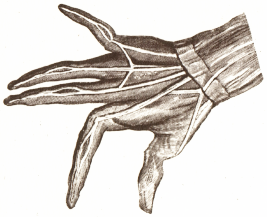
These are a common hazard and, contrary to popular belief, do not require professional medical attention. If a limb is broken, merely adjust the bones using a straight-edge ruler until they line up properly. Then bind the bones with a “splint” (a two-by-four tied with several kerchiefs) so that they remain in line for at least a week or two. The break, once healed, will actually be stronger than the original bone… although we do NOT recommend you break each and every bone just to create stronger, healthier limbs!
Occasionally, bones other than limbs will also break (ribs, skull, pelvis, shoulder blades); these cannot be set using a splint. Fortunately, these tend to heal on their own when left alone. Try to avoid placing undue or uncomfortable pressure on these bones for several weeks or until firmly set.
These are simply the result of broken blood vessels underneath the skin, a natural and spontaneous occurrence which should not be viewed as serious. However, they are unsightly and can be painful. See the above Pharamacopoeia for several alleviateing substances, most notably the application of several leeches to the immediate area. The discoloration should quickly subside.
Note that in some cases, the bruises may actually swell or raise the surface of the skin. These are merely pools of blood; to eradicate the swelling, simply “squish” the blood around to the surround tissue and even out the surface. This is best accomplished with a standard kitchen rolling pin.
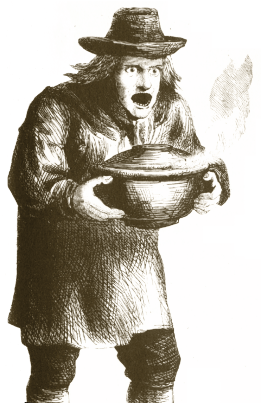
There is a saying in the medical profession: “The only people who get burns are the people who deserve them.” This is our way of saying that burns can nearly always be prevented simply by being attentive, aware, alert and intelligent.
Nonetheless, there are many -- most notably children -- who will occasionally suffer from burns. In either event, the application of a soothing balm or calamine lotion will aid in healing and reduce the chance of infection. However, it is generally understood by doctors that they will not treat burns that were arrived at through clumsiness and stupidity. Pain and a rapidly spreading infection are excellent and constant reminders of the need to be cautious when dealing with heat and flame.
Choking is caused by a foreign object or wayward chunk of food being lodged in the windpipe. Fast, thoughtful action is a must if a choking victim is going to be saved from asphyxiation.
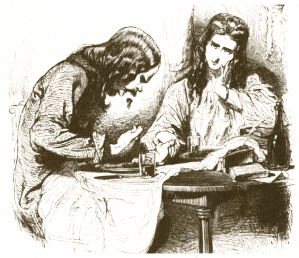
First, ascertain that the victim is indeed choking. If the victim gags violently and turns blue, this may simply mean that the victim has swallowed something extremely cold and distasteful. Cover the victim with blankets and provide plenty of strongly-flavored hot tea.
Should you determine that the victim is indeed choking, the first course of action is to force the victim to swallow as much liquid as possible; the weight of the liquid may be enough to propel the lodged object further down the gullet and, eventually, into the stomach where it belongs.
If this does not seem to work, take your command household plunger (also knows as the “plumber's helper”) and apply it around the mouth and nose of the victim. Three or four quick plunges will dislodge any item. Sometimes just the smell of the thing will help bring something up!
The saying goes, “Feed a fever, starve a cold.” Mankind has yet to determine the precise cause of the common cold. We are, though, reasonably sure that certain activities can trigger the onset of a cold: walking in cold weather without a coat of some sort; sitting in a bath whose water has gone cold; getting wet and not drying off promptly.
While there is no cure for a cold, there are symptomatic treatments. Hot beverages will soothe a sore throat and promote the loosening of phlegm in the chest. Placing ice cubes in the nostril will draw the cold up and out the nose, away from the chest and throat. Attaching clothes pins to the lips will push infected blood away from the head and closer to the heart, where the immune system is strongest. And placing a vacuum pump down the esophagus will help draw away accumulated phlegm.
While none of these treatments will cure the cold, they will go a long way towards making the cold sufferer more comfortable.
Constipation is an unnatural hardening of the stool, making voiding difficult and strenuous. If unchecked, it can lead to hemorrhoids and other afflictions of the lower bowels.
The key to curing a bout of constipation is to eat plenty of soft, liquidy foods. Some of the best are: soft or melted cheese, milk, butter, eggs, cooked beef and melted chocolate. Laxatives such as Psyllium are also recommended, but only when more natural remedies fail.
Corns are horny thickenings of cuticle, typically found on the feet; in animals, esp. horses, corns refer to a morbid condition of the fore hoof resulting in inflammation of the horn (produced by tissue damage to the sole). Corns can usually be made better simply by picking at them; soaking them briefly to soften them first helps make them more pickable.
Can refer either to a general inflammation of the larynx, resulting in a painful spasm or cough, or to a specific condition in which a false membrane develops over the throat accompanying the coughing and spasms. Croup is best treated by the ingestion of hard, rough-textured food such as rock candy (swallowed in chunks) and bread crusts, and highly acidic foods such as freshly squeezed lemon juice or vinegar. The rough-textured foods scrape the infected tissue off the throat and into the stomach, where the digestive juices will dissolve it; the acidic foods also “burn off” the infection and thus soothe the inflamed tissue.

Is caused by a lack of fluid in the body. Under ideal circumstances, the body produces enough fluid to sustain life on its own; we drink to satisfy thirst, not to prevent dehydration. Thus when a person exhibits the signs of dehydration (flaking of skin, falling hair, dry eyeballs that refuse to blink, etc.), do NOT give the patient additional fluids! Given enough time, the body MUST learn to produce these fluids itself! Ingesting fluids into the body will only delay dehydration and prevent the body from developing its own natural defenses!
Diarrhea is caused by too many soft, liquidy foods finding their way into your digestive system. Unchecked, it can lead to dehydration. It may be cured quickly and cleanly by eating quantities of solid foods, or foods with stiffening ingredients like pectin, such as: fibrous breads, apples, cruciferous vegetables like broccoli and cauliflower, etc. ( see: BISALICYLATE ANTITOXIDENE.)
The saying goes, “Feed a cold, starve a fever.” In this case, “starving” refers to not giving a fever what it wants: warmth. A person suffering from an elevated temperature (anything above 98.6 when taken with an oral thermometer, above 99.6 when taken with a rectal thermometer, 97.6 when taken with a nasal thermometer, or 84.3 when taken with an outdoor thermometer) should be immersed in ice water until the fever breaks.
Properly treating flatulence, whether in man or beast, requires diagnosing the source of the offensive odor. Obtain a sample of the gaseous matter (any simple container, such as a paper bag, will suffice). Place your gas spectroscope (you do still have that old gas spectroscope out in the barn, don't you?) in front of a lit alcohol lamp or Bunsen burner. Burn the gas on the flame and observe the spectra readout. Compare the readout to the tintypes below and treat with the appropriate solution:
| Apples 'n Brown Sugar-Cinnamon (treatment: Sodium Bicarbonate) |
|||
| Excess Acid or Excess Carbon Dioxide (treatment: Nitrabylocynine) |
|||
| Caramel (treatment: Quinine) |
|||
| Meaty By-Products (treatment: Bisalicylate Antitoxidene) |
|||
| Lentils (treatment: Aminophyllic Citrate) |

One of the most feared sicknesses of all time, heart attack is the result of a sickly constitution. Preventive medicine is best. A healthy constitution must be fomented by a varied, healthy diet. Eat plenty of rare red meat, liver, pork, eggs, cream, cheeses, and fried foods; supplement this with homegrown vegetables such as potatoes, corn and peas; pure white bread for fiber; and fruits when available (however, be warned: fruits may contain worms and other impurities and should only be eaten sparingly).
In the event of a heart attack, the victim may feel shooting pains in the left arm and centralized pain in the chest. The patient should immediately grasp the wrist to feel the pulse, breath shallowly, turn pale, sweat, and say, “Oh, no! I'm coming, Esther!” over and over in order to stay awake. Crumpling to the floor is optional. After a period of panic, bed rest is prescribed, accompanied by heavy dosages of self-recrimation for an unhealthy lifestyle.
Esophagitis, a burning sensation of indigestion that manifests itself in the upper abdomen. Antacids may be used to alleviate the symptoms temporarily, but in chronic cases, an esophagotomy may be required. This surgery is best performed in a hospital or barber shop.
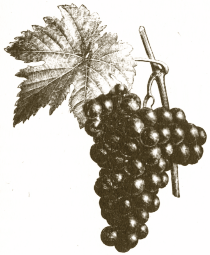
Also known as “piles,” characterized by a swollen mass of varicose veins in the rectum, which sometimes protrude in a manner resembling grapes, and… you don't really want to hear this, do you? Good, because I'm getting just a wee bit nauseous talking about it.
Balms and ointments applied to the area may offer symptomatic relief; however, for longer-lasting relief, a change of diet is prescribed. Chronic constipation can result in hemorrhoids, thus the same dietary considerations for that condition may alleviate hemorrhoids. The rule of thumb is, don't strain. Take it easy when voiding. If you sit there, it will come.
Small, hard, jagged stones or collections of improperly metabolized minerals, often calcium, but sometimes other materials, such as Pez. They can range in size from a peppercorn to a small pitted cherry, and may often be passed without any discomfort save that as a man might experience while birthing a baby through his penile member.
Chronic production of kidney stones may indicate kidney or liver dysfunction, and the long-term treatment involves dietary restrictions on foods with any mineral content. This may mean no dairy products whatsoever, which are calcium-rich, as well as the exclusion of many meats and vegetables. The most painful dietary consideration may be to completely eliminate one's intake of tofu, another calcium-rich food. Many have chosen to learn to live with kidney stones rather than succumb to their inability to properly digest tofu.
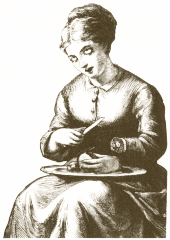
A catch-all phrase generally referring to a cut or injury to the skin. Once upon a time, lacerations were attended to by cleansing the skin thoroughly and stitching the skin together to minimize scarring. However, although we still look favorably upon cleansing lacerations to avoid infection, we are now enlightened enough to realize that scars, far from being objects of scorn and derision, are symbols of fortitude and life experiences. Rare and reviled is the man who has no scars to show for his life on this earth; therefore, we no longer stitch scars unless they appear life-threatening.
Should you wish to draw attention to particular nasty laceration, a pat of mercurochrome is always a nice decorative touch, and the application of peroxide to the laceration, with its resulting fizzing and bubbling, always makes for an impressive show of endurance.
A viral infection causing a spotty red rash, fever, runny nose, sore eyes, cough, and possibly additional complications, Untreated (or improperly treated) measles can cause encephalitis, a dangerous and sometimes fatal inflammation of the brain.
There is currently no treatment for measles in our stage of scientific development, other than pushing fluids and taking aspirin, so just sort of count on encephalitis.
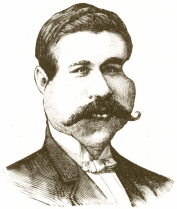
Another acute viral infection (collect the whole series!), usually confined to the childhood years. Mumps are characterized by inflammation and swelling of the salivary glands and, in teenage and adult males, swelling of one or both testes.
Fortunately, complications are rare, and one bout with mumps confers future immunity. Analgesics are dictated but there is no specific cure known at this time. The only long-term side effect is the social stigma of walking around looking like you're storing nuts for the winter in your cheek pouches. It is not unusual to be given nicknames such as “Squirrel cheeks,” “Dizzy,” or “Brioche Face” while thus afflicted, and these nicknames may endure for years, causing embarrassment and ridicule that may endanger psychological health during the crucial adolescent years.
Just something to look out for.
The sensation of wanting or needing to vomit. While nausea itself is not an illness or disease, but rather a symptom, nausea can be treated with Bismuth Subsalicylate. When a patient becomes nauseous, do attempt to determine the cause of the underlying illness. It isinteresting to note that although man is not the only creature to experiences nausea, man IS the only creature to feel a need to “kneel before the porcelain goddess” first in order to make the offering.
Three species of plants that are both poisonous if taken internally and also liable to cause allergic reactions if touches.
Identifying the plants may go a long way towards preventing accidental exposure. Poison ivy and poison oak have three leaves in a cluster; poison sumac has a row of paired leaflets. Of course, this could describe any of thousands of non-poisonous common plants, so the only surefire way of determining whether a particular plant is poisonous or not is to rub some briskly on an unimportant, unused part of the body (the head would probably be appropriate in this case).
First-aid consists chiefly of cleansing the affected area, swabbing with alcohol and then with calamine lotion. Wash any clothing that may have come in contact with the plant. People with extremely severe or unsightly reactions to poison ivy, oak or sumac should probably be sterilized so as not to pass on this allergy to the next generation.
A collective term for any of a number of infectious diseases resulting in blistery, weeping skin eruptions (such as chicken pox). However, it is also used to refer to a disease also called “syphilis,” inaccurately known as the “love disease” since it seems to be passed on primarily by outhouse seats with inadequate openings.

A temporary, usually non-fatal condition involving a parasitic embryo, a host female, and a disinterested third party (usually a father). The embryo attaches itself to the inside of the female's uterus and feeds off of her blood and other bodily fluids, growing very rapidly, much like a tapeworm, only rounder. Fortunately, the parasite usually detaches itself (See: KIDNEY STONES for a description of the pain involved in this process.) within 8-9 months, after which its parasitic tendencies become largely financial in nature.
Fortunately, we now know that pregnancy is entirely preventable simply by staying home on Friday and Saturday nights.
Psoriasis is a specific skin condition in which epidermal cells are manufactured faster that normal and not allowed to mature, resulting in an excess supply of immature skin cells which flake off rather that hang around and finish school. It may also cause heartbreak.
Dermatitis is a general term for any non-specific inflammation of the skin, attributable either to allergies or unknown causes. Eczema, seborrhea, and dandruff are all examples of dermatitis. Fish oil is believed to help alleviate both psoriasis and other dermatitises, but many would rather live with the condition that walk about smelling of mackerel.
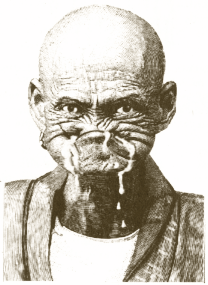
An acute viral infection of the nervous system, usually fatal, often passed on to humans through contact with animal saliva. There is no current treatment for rabies.
One of the most commonly acknowledged symptoms is the intriguing “foaming at the mouth” bit. This symptom is highly overrated. The foaming is no big deal; it's not a big frothing mass like a bubble bath. In fact, it's quite subtle, a thin foam resembling crème fraíche or a light hollandaise. By the time you've spotted it, it's usually too late. Cut and run.
A pain that radiates up and down the sciatic nerve (primary nerve of the leg). Spinal injuries are the most common reason for sciatica, though it may also be caused by tumors, abscesses, blood clots, or simply by incorrect posture. Treatment consists of bed rest andanalgesics; the symptoms usually disappear within a few days.
Sciatica, being one of those conditions little understood by the general public, is an excellent excuse to stay home from work. “My sciatica's acting up again” is a colorful and quaint complaint, and since the average Joseph has no idea whether or not it's contagious, he's likely to grant you a respite from work until you are better. (Rabies is also a splendid excuse to stay home from work, but generally only works once.)
This is simply inflammation due to excess exposure to the sun. These days, the risk of sunburn may easily be lessened by using what's called a “sun block.” Tar, molasses, white oil paint and most laxatives, either singly or in combination, make effective sun blocks.
Should you forget to bring your bucket of tar to the beach, sunburn may be soothed with an application of calamine lotion. Alternatively, a rubefacient applied to the areas NOT affected by sunburn will at least spread out the discomfort.
Also results from overexposure to direct sun, usually afflicting those who are unaccustomed to hot temperatures. Sunstroke (and other heatstrokes) are life-endangering if not treated promptly, as the body's heat-regulating mechanisms break down and allow the body to literally overheat.
Fast treatment consists of wrapping the patient, naked, in a cold, wet sheet. Douse the sheet continuously with extra water, or repeatedly sponge the victim with cold water. Force-feed the victim quiescently frozen confections. Continue until the patients' internal temperature registers 101 degrees on a rectal thermometer.
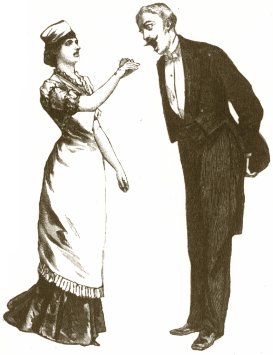
Contagious but harmless growths on skin or, occasionally, on mucus membranes.
Warts can be frozen off or picked off (be sure your fingernails are clean), but the most effective treatment for removing or “fetching” a wart is that prescribed by Samuel Clemens involving stump water and a dead cat at midnight. See. TOM SAWYER.
Game Designers:
Al Lowe
Josh Mandel
Director/Producer:
Josh Mandel
Art Designer:
Bob Gleason
Lead Programmer:
Steve Conrad
Composer:
Aubrey Hodges
Lead Animator:
Karin Young
Character Designer:
Ruben Huante
Programmers:
Cynthia L. Swafford
William R. Shockley
Steve Conrad
Artists/Animators:
Phy “No Relation” Williams
Bob Gleason
Ruben Huante
Karin A. Young
Quality Assurance:
Mike W. Pickhinke
Additional Animation:
Jeff Crowe
Joan Delehanty
Maria Fruehe
Gloria Garland
Michael Hutchinson
Tony Margioni
Jerry Moore
Cindy Walker
Chris “Smokehouse” Willis
Deanna Yahlkee
Additional Programming:
Carlos Escobar
Doug Oldfield
Configuration Lead:
Doug Wheeler
Quality Assurance Configuration:
Mike Brosius
Dave Clingman
Keri Cooper
Lynne Dayton
Tina Deardorff
Mike Jones
John Meek
Diana Mulligan
Sharon Simmons
Additional Quality Assurance:
Joe Carper
Judy Crites
Bill Davis Jr.
John Ratcliffe
Sharon Smith
Dan Woolard
Additional Music/Effects:
Rick Spurgeon
Systems Programming:
Vana Baker
Ed Critchlow
Dan Foy
J. Mark Hood
Brian K. Hughes
Ken Koch
Jack Magne
Terry McHenery
Martin Peters
Larry Scott
Christopher SmithMark Wilden
Customer Service Liasons:
Larry Buchanan
Mike Weiner
Documentation Writers:
Josh Mandel
Al Lowe
Documentation Design:
Nathan Gams
Special Thanks:
Bob Ballew
Alan Mandel
The Freddy Pharkas Beta Testers